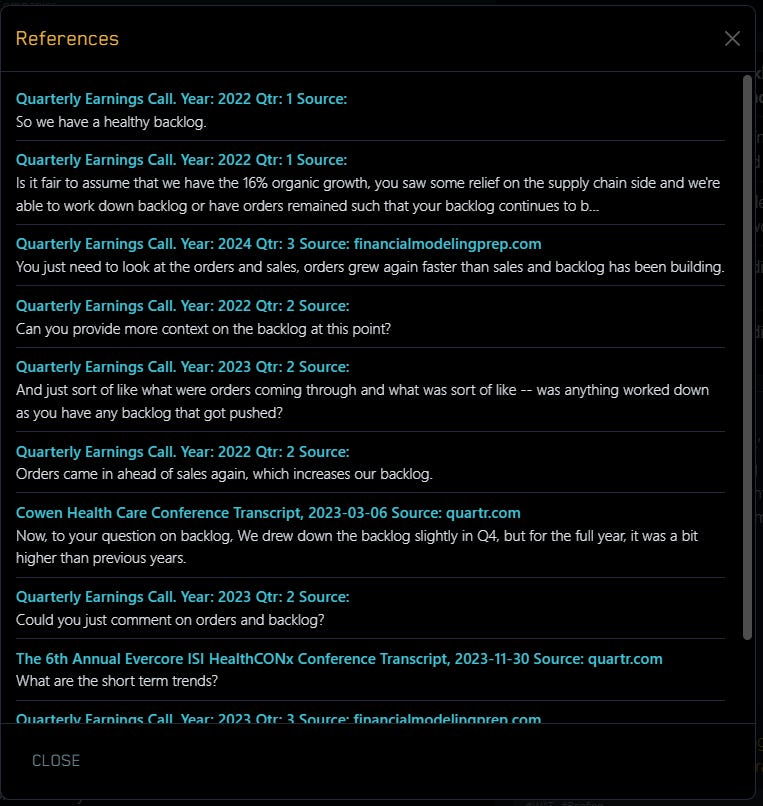The life sciences industry is one I’ve followed over the years since Danaher’s acquisition of Beckman Coulter back in 2011. I keep tabs on Danaher and most of the other companies in the industry: Thermo Fisher, Sartorius, Agilent, Repligen, Revvity (formerly Perkin Elmer), Bruker, Waters, Bio-Techne, and Waters. Needless to say, it takes a lot of time to review transcripts for all these companies every quarter to monitor how sentiment, growth rates, order rates and backlogs have evolved. Sometimes I just throw up my hands on the companies I care the least about and tell myself I’ll catch up with such and such company next quarter…
Being stretched for time, I’ve been doing my best to experiment with the new AI tools out there in the hopes of speeding up the quarterly review process. One tool I’ve been experimenting with is Google’s NotebookLM. I’ve been trying to use it to get more up to speed on companies and industries. I’ve also tried to use it to gauge shifts in tone and sentiment from management.
To use NotebookLM for these purposes, I have to download all the transcripts for the companies as PDFs and upload them into NotebookLM. Doing this for ten companies—transcripts for quarterly calls and sell side conferences—probably takes 15-20 minutes, but always feels like forever. Pure drudge work.
When I’ve uploaded everything, I can ask NotebookLM to summarize everything or ask further illuminating questions like, “How have backlogs evolved over the last six months for each company?”. The results are decent, but again, it just felt like torture to get there. So I’ve recently been demoing a new AI tool that has been designed specifically for investors who want to quickly get up to speed on a company or an industry: Tenzing MEMO.
I actually tested Tenzing a few years ago in its earliest alpha build to provide feedback to the creators of the service. But I’ve recently seen Todd Wenning of Flyover Stocks showing in some of his posts how he is using the current Tenzing build. I also saw very high praise from Santangel’s Review. I thought it was time to give Tenzing another try and see what has changed.
Tenzing Process
With this trial of the new Tenzing, I focused on queries to update my understanding on the life sci and biotechnology industries. First and foremost, the process is absolutely much faster and less arduous compared to the way I was doing things with NotebookLM. There is no need to download and upload transcripts, 10-Ks, or proxy statements as they are already in their system. You can start querying immediately.
Nevertheless, Tenzing still allows the user to upload additional documents and PDFs for the company in question. Let’s say you have a transcript of an interview you conducted with an expert. You can upload that and Tenzing will factor it in to its own summaries as well as your new questions about the company in question.
Here was my first query to Tenzing:
“What have the following companies said about order rates, backlogs, and new equipment and new instrument sales over the last six months? WAT, BRU, A, DHR, TMO, TECH, RGEN, and Revvity”
The response gave me what I was looking for: a concise, bullet-pointed summary for each company. Tenzing even recognized that I meant “BRKR” for Bruker when I mistakenly typed in “BRU”.
Even more impressive, as I was waiting for the answer I was thinking to myself, “I wonder if I can then ask Tenzing to organize the output into a table?” Amazingly, just as I was thinking that thought, it generated a summary table at the end of its answer without a follow-up prompt!
Trust, But Verify
But let’s not stop there. We need to verify this output, especially since I started with such a complex question. Let’s focus solely on Waters and double-check to see if order rates and backlog for the company have actually improved like Tenzing says it has. Here was my prompt:
“Prove to me that order rates and the backlog for WAT have improved now vs. a year ago.”
Tenzing provided four categories supporting its answer along with greater detail in the form of quotes from earnings calls and other sources. From here, I could then click deeper to see the actual references used to formulate the answer. Unfortunately, the list of sources did not line up well with my specified time frame. You can see it uses sources from 2022 and 2023, so now I know the original answer needs some verification from my end.
After some fact checking, I found that one of the management quotes Tenzing claimed was from the Q1 2025 call was actually from the Q3 2024 call. OK, so no AI tool is perfect yet.
From here, I kept refining my question regarding Waters and then checking the references. What I learned in the process was that highly specific questions about a single company produced the best answer supported by the best evidence. So rather than start with a question like this:
“How have order rates and backlog for WAT changed now vs. a year ago?”
It is best to increase specificity and chunk it into two questions to accurately compare two different time periods:
“What did WAT management say about order rates and backlog on their Q1 2025 call”
“What did WAT management say about order rates and backlog on their Q1 2024 call”
Governance and Proxy Statements
Another thing I liked about Tenzing is it already has 14 areas of focus that are immediately ready for the user. Governance is just one of the 14. You hit the button and it distills the entire proxy statement into something easily readable. Tenzing definitely hits the mark here as there is usually only a limited amount of information in the proxy that is worthy of an investor’s attention.
After reviewing Tenzing’s summary of “Governance” for Waters, I was impressed yet again with the potential power of the natural language queries I used. For example, I asked Tenzing to show me a table for the total shares and vested options/RSUs owned by Waters executives and what they were worth based on the most recent share price. Done in a few seconds. Easy.
However, I just could not resist asking Tenzing yet another complex question covering a long time frame:
“How have the performance-based incentive metrics changed over the last five years for Waters?”
This is one of many things I like to check when evaluating a business. If there have been frequent or significant changes, that begs further investigation. Is the company incentivizing acquisitions at any cost (see what happened to Omnicell) or are they using reasonable metrics to encourage the right mix of long-term growth and profitability? Or have there been changes that might signal the company will try to sell itself in the next few years?
Tenzing came at me again with a well-organized list of metrics by year. It also followed this up at the end by producing a table and a three-sentence summary. And it took about 15 seconds. Compare this to my old method of finding each annual proxy statement, hitting “Ctr+F” to find the right section, then reading it, and then typing up my own brief interpretation of the data and verbiage into an Excel spreadsheet or notetaking tool. I’m guessing this normally would take me 15-20 minutes of work for five proxy statements of a single company.
But to warn you yet again, I have not yet taken the time to fact check the above results, so I have no idea of the accuracy. Still, there is amazing potential here for time savings on my end when I can rely on the accuracy and veracity of such a query. The scaffolding is there. It’s just a matter of when we can confidently rely upon the answer to a complex question, not if.
Summary
I’m highly impressed with how Tenzing MEMO has evolved in such a brief time. It has an excellent user interface and experience. For the typical questions and checklist items of an investor, it can provide quick summaries in pretty much the exact format I would create for myself. Most importantly, it provides convenient reference links to the resources that fueled the answer so you can double-check veracity.
I can absolutely see how this tool can: (1) cut the time I spend on keeping up with companies I follow and (2) accelerate the research process on a new company or an entirely new industry with which I am unfamiliar. I highly recommend any serious investor check it out. And like with all Natural Language Processing and AI tools, don’t forget to be specific and to verify.
Please Share and Subscribe
If you enjoyed this content, please share and subscribe. Leave a comment as well if you have the time!
Disclaimers for this Substack
The content of this publication is for entertainment and educational purposes only and should not be considered a recommendation to buy or sell any particular security. The opinions expressed herein are those of Douglas Ott in his personal capacity and are subject to change without notice. Consider the investment objectives, risks, and expenses before investing.
Investment strategies managed by Andvari Associates LLC, Doug’s employer, may have a position in the securities or assets discussed in any of its writings. Doug himself may have a position in the securities or assets discussed in any of his writings. Securities mentioned may not be representative of Andvari’s or Doug’s current or future investments. Andvari or Doug may re-evaluate their holdings in any mentioned securities and may buy, sell or cover certain positions without notice.
Data sources for all charts come from SEC filings, Koyfin, and other publicly available information.









Good write-up. Interesting